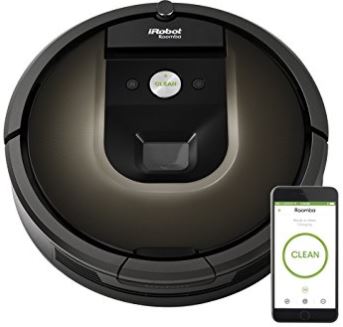
Robovacs
By Wayne Maruna
Technological advances often end up adding new words to our lexicon. One such word is “robovac”, a contraction of the words 'robotic' and 'vacuum'. For me, the word 'robovac' use to conjure up an image of Robbie the Robot from Lost in Space wearing an apron while pushing around an upright vacuum. Today’s reality is quite different.
My first encounter with a robovac, early 21st century style, came when a friend was given one by her adult son. It looked more like a pregnant Frisbee on miniature roller skates. I didn't really pay it much mind since I figured it was just a fad. But now several years later, the modern robovac is still with us, improving and proliferating.
I was recently at someone's
house when I saw what I thought was a round digital scale plugged into a wall
outlet. It turned out to be their iRobot
Roomba robovac, sitting in its charger, sipping electricity while preparing to
run off and gather dog hair and smatterings of garden soil. Its owners told me
it was actually quite effective at those tasks, as much of their floor surfaces
were hardwood or tile.
We don't have pets at our house but my wife, who has the ability to see dirt I do not, gets obsessive with her wet Swiffer from time to time, as she has the ability to see dirt that I do not. Surely she would appreciate the assistance of her own computerized vacuum cleaner, I thought. So it was off to the web to learn about robovacs.
For all I knew, all robovacs came from iRobot, the dominant brand name. Boy was I wrong. An Amazon search revealed many brand names I had never heard of, names like Eufy and Deebot and Xiaomi, and some familiar names like Samsung. You can grab a copy of the January, 2018 Consumer Reports to see a more extensive list of brands. Prices vary widely, from as little as $100 on the basic end to $1,000 on the high end. Yes, you can buy a lot of wet Swiffers for a thousand bucks.
While
I was willing to dip my toes into the robovac waters, I wanted to stay out of
the deep end. I opted for a $200 iLife A4S which got very good customer reviews
on Amazon. It came fully assembled and all I had to do was set it in its docking
station and let it charge up. Then I pressed 'Clean' on the included remote, and
the little guy backed out of its dock and proceeded to meander in what seemed
like an aimless fashion around the floor, changing directions on a whim. It was
akin to watching an unleashed male dog making its way through a forest, dashing
randomly from one tree to another. It did a good job of not running headfirst
into furniture, and it supposedly had a 'cliff sensor' to keep it from plunging
down stairs. It ran hither and yon for over two hours, and then sensing its
diminishing battery power, it beat a path back to its charger and docked itself. A check
of its dirt bin revealed that it had been diligent in its endeavors.
So what do you get as you move up the price ladder? You'll likely get smart phone features that allow you to start an unscheduled cleaning session remotely. You may get a robovac that not only runs home to recharge, but once juiced up, returns to where it left off to finish the job. Higher end units can also laser-map a room so that it performs its job in a more intelligent manner than random tree sniffing.
Ultimately I returned the iLife A4S, as I was uncomfortable with its programming that seemed to be based on some combination of Chaos Theory and Blind Squirrel Theory. I opted for a bit more expensive laser-mapping Xiaomi Mi model that supposedly does what the $900 Roomba does for considerably less money ($400 Amazon, $326 Gearbest.com direct from China.) Admittedly, iRobot's service network is more firmly established so I am taking some risk on down-stream repairs. And oh yeah, the Xiaomi user manual is written entirely in Mandarin. Fortunately, YouTube has videos to explain setup and operation, and I did find an on-line user manual in English. The Xiaomi does not come with a remote control, but it connects to your Wi-Fi router and uses a smart phone app (available for iOS or Android) to control the device and show a map of its travels.
Do robovacs work? Survey says yes, especially on hard surfaces and to a lesser degree on low pile light colored carpeting. (Dark carpeting may confuse the cliff sensor.) They seem to do a commendable job with pet hair and fur, but you do have to do regular post-cleaning maintenance to empty the dirt bin and remove accumulated fur from the rollers.
Are there common issues? Yes. Robovacs are prone to get tangled up with fringes and tassels on throw rugs, and can be brought to a halt by tangling themselves on electrical cords or getting stuck trying to go under very low furniture. It's a good idea to police the area your robovac is about to clean, especially if you have pets prone to 'accidents'. There are some pretty ugly customer tales in that regard. Just remember the word 'smear'. More than enough said.
Overall, folks seem to be quite pleased with their little robovacs, even giving them names. One Taberna resident said her robovac of eight years (!) is named Ruth, and I got the impression they were on quite good terms. Roscoe the Roomba lives three doors from me. Another resident has a house robovac named Scoobie and a unit for her garage named Dirt Dog. “Remember to close the garage door”, she warns. I can see the TabMail now: “Black robovac running loose on fairway nine”.
Late flash - I'm told that Scoobie now has a new stable mate, Ruby, a Shark Ion RV750 model. Ruby's owner is very impressed with her performance and told me that Ruby has chased down an amazing number of dust bunnies from under the bed.

My favorite 'pet name' for a robovac though came from a reviewer on Amazon who named her robovac “Vlad the Inhaler.”